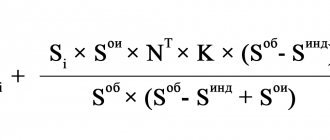What formulas are used when calculating heating fees?
Clause 42(1) of the Rules for the Provision of Utility Services describes in what cases (in the presence (absence) of a general public utility and (or) IPU) and by what formula the payment for utility services is calculated.
According to this standard, payment for heating utilities in apartment buildings is carried out in one of two ways: during the heating period or evenly throughout the calendar year. If there is no operating budget in the house, the amount of payment for the heating utility service is determined by formulas 2 and 2(1) from Appendix 2 to the Rules for the Provision of Utility Services based on the consumption standard for the heating utility service. If the apartment building is equipped with a fire control unit, but not all residential or non-residential premises have installed heat control units, the amount of payment for utility services for heating in the premises is determined using formulas 3(1) and 3(2) from Appendix 2 based on the average monthly volume of heat energy consumption for heating for the previous year, determined according to the readings of the operational control unit. If the apartment building is equipped with a fire control unit and all residential and non-residential premises have IPU installed, the amount of payment for utility services for heating in the room is determined using formulas 3(3) and 3(4) from Appendix 2 based on the readings of such meters. In a new apartment building that has been put into operation, equipped with a public utility system, all premises are equipped with a public utility system, therefore, formula 3(3) should be applied and the amount of payment should be adjusted once a year according to formula 3(4), if the executive authorities of the relevant constituent entity of the Russian Federation have established a method of payment for utility services for heating during the calendar year.
Consumption standards
Each subject of the Federation has a body that determines the amount of any energy necessary for the needs of the population. Usually they are regional energy commissions. The norm is established each time for three years and is adjusted if necessary.
The table below provides information on the tariffs existing in different regions of the country:
Table 1.
| Region | Tariff (r/Gcal) |
| Moscow | 1747,47 |
| St. Petersburg | 1678,72 |
| Murmansk | 2364,77 |
| N-Novgorod | 1136,98 |
| Novosibirsk | 1262,53 |
| Khabarovsk | 1639,74 |
| Vladivostok | 2149,28 |
| Birobidzhan | 2339,74 |
However, with the beginning of the cold period of the year, the cost of a utility resource will increase by approximately 100 rubles.
How to calculate the fee if the IPU readings are missing?
Let us remind you that, according to clause 36 of the Rules for the provision of public utility services, the management company is obliged to make calculations only in accordance with these rules. In other words, if all premises in an apartment building are equipped with heat insulation control units, the calculation should still be carried out using formulas 3(3) and 3(4), even if not all consumers transmit meter readings. At the same time, by virtue of paragraphs. “z” of clause 31 of the rules, the contractor is obliged to notify consumers at least once a quarter by indicating in payment documents: – about the timing and procedure for taking IPU readings by consumers and transferring the relevant information to the contractor or his authorized person; – on the application in case of failure by consumers to provide information on meter readings of the information specified in clause 59 of the Rules for the provision of utility services. According to this paragraph, the payment for utility services for heating (when, in accordance with paragraph 42(1) of the rules, the IPU readings are used to determine the amount of the payment) is determined based on the average monthly (for the heating period) volume of consumption in the following cases: a) in case of failure or the loss of a previously put into operation IPU or in the event of expiration of its service life from the date when the specified events occurred until the date when the accounting of the utility resource according to the IPU was resumed; b) if the consumer fails to provide IPU readings starting from the billing period for which the meter readings were not submitted, until the billing period (inclusive) for which the consumer provided the IPU readings to the contractor; c) in the event of a consumer’s refusal to gain access to the IPU (see paragraph “d”, clause 85 of the Rules for the Provision of Public Utilities) and the contractor draws up a corresponding act starting from the date when the contractor drew up the act of refusal of admission to the IPU until the date of the checks. In all of the above cases, the calculation is made for such a consumer based on the average monthly volume, but not more than three billing periods in a row. How to determine the fee after the specified three months?
Payment for heat in a communal apartment
The principle of calculating the services for heating a room in a communal apartment is the same as when determining the amount of payments under the general public utility. All that needs to be done is to determine the share of the room owner in paying the total bill.
Mandatory calculation data:
- Pk – room square;
- By – area of the apartment according to the passport;
- Po – total heat energy consumption according to meters or established standards;
- T – cost of 1 Gcal.
The calculation is made as follows:
O = Po x Pk/Po x T
The testimony of the IPU has not been transferred: three months have passed.
According to paragraphs. “b” clause 82 of the Rules for the Provision of Public Utilities, the contractor is obliged to check the accuracy of the information provided by consumers about the readings of IPUs and distributors by checking them with the readings of the corresponding meter at the time of the check (in the case when the readings of such meters and distributors are taken by consumers). These checks must be carried out by the contractor at least once a year, and if the metering devices being checked are located in the consumer’s residential premises, then no more than once every three months. As follows from clause 84 of the Rules for the Provision of Utility Services, if the consumer fails to provide the contractor with IPU testimony for six months in a row, the contractor no later than 15 days from the date of expiration of the specified six-month period, another period established by the agreement containing provisions for the provision of utility services, and (or ) by decisions of the general meeting of owners of premises in the apartment building, is obliged to conduct an inspection and take meter readings. This means that if the consumer fails to provide monthly IPU readings within six months, the executor not only has the right, but is also obliged to check the consumer’s IPU readings. However, there is some inconsistency in this norm, since based on the average monthly volume, in case of failure to provide IPU readings, only three billing periods in a row can be calculated [1], and the contractor is obliged to check the IPU readings only after six months. A completely fair question arises: how to make payments in the fourth, fifth and sixth billing periods? In such a situation, we consider it necessary for the management company not to wait for six months and to check the IPU after three months, since the contractor has this right according to clause 82 of the Rules for the provision of utility services . The procedure for conducting such a check is set out in paragraph 84 of the rules. According to clause 85(3) of this document, in the event of drawing up the act provided for in clause 85 of these rules on refusal of access to the metering device after three billing periods from the date of drawing up such an act, the executor has the right to calculate the payment for utilities based on the utility consumption standard taking into account the number of persons permanently and temporarily residing in the residential premises, as well as taking into account the increasing coefficient starting from the 1st day of the month in which such an act was drawn up. The value of the increasing coefficient is assumed to be 1.5. It would seem that everything is simple. If the consumer has not provided the IPU readings: - for the first three months, the management company calculates the fee based on the average monthly volume of consumption (according to the IPU data for past periods); - then it conducts a check and, if an act of refusal of access to the meter is drawn up, after three months it calculates payment according to consumption standards with an increasing factor ( Pi = Six NT x 1.5 x TT ). This procedure should encourage the consumer to provide evidence of the IPU.
However, clause 85(3) of the Rules for the provision of public utility services came into force only on 01/01/2017, and we see that the legislator did not think through the possibility of its application, since he did not make changes to formula 3(3) from Appendix 2 to the rules. Let's present it for clarity.
Vin – volume (quantity) of thermal energy consumed during the billing period in the i-th residential or non-residential premises in an apartment building, determined when paying for utility heating services during the heating period according to the readings of the IPU in the i-th residential or non-residential premises, and when paying evenly throughout the calendar year - based on the average monthly volume of thermal energy consumption for heating in the i-th residential or non-residential premises according to the IPU readings for the previous year;
Viodn – volume (quantity) of thermal energy provided during the billing period in an apartment building equipped with a thermal energy control unit, with the exception of the volume (quantity) of thermal energy consumed in all residential or non-residential premises in an apartment building, which is determined by the formula:
Vd – volume (quantity) of thermal energy consumed during the billing period in the apartment building, determined when paying for utility services for heating during the heating season according to the indications of the operating budget, and when paying evenly throughout the calendar year - based on the average monthly volume of thermal energy consumption for heating in MKD according to the testimony of the OPU for the previous year;
Si – total area of the i-th premises (residential or non-residential) in the apartment building;
Sob – total area of all residential and non-residential premises in the apartment building;
TT – tariff for thermal energy, established in accordance with the legislation of the Russian Federation.
It turns out that when the contractor uses the consumption standard to calculate the heating fee for an unscrupulous consumer who does not submit IPU readings for three billing periods in a row, the contractor will receive less payment for heating in terms of the volume on the ODN. The fact is that the heating utility standard ( NT ) includes the consumption of thermal energy not only in the room, but also in the central heating unit. It turns out that in the conditions of application of the standard when calculating fees for consumers who do not give IPU readings, when calculating fees for consumers who provide meter readings, according to formula 3(3), the indicator Viodn is already reduced by the volume of consumption per UDN contained in the standard for the consumer, who did not give evidence.
This means that in formula 3(3) from Appendix 2, instead of the total area ( Sob ), it would be more logical to use the total area of the premises of only those consumers who take readings of the heat IPU.
When applying the formulas in their current form, the contractor will be forced to pay the difference under the ODN at his own expense, however, taking into account the fact that, according to clause 85(3) of the Rules for the provision of utility services for an unscrupulous consumer, an increasing factor of 1.5 is applied, the contractor’s expenses will most likely be will be compensated.
What is Gcal
We should start with a related definition. A calorie refers to the specific amount of energy required to heat one gram of water to one degree Celsius (at atmospheric pressure, of course). And due to the fact that from the point of view of heating costs, say, at home, one calorie is a tiny amount, gigacalories (or Gcal for short), corresponding to one billion calories, are used for calculations in most cases. We've decided on this, let's move on.
The use of this value is regulated by the relevant document of the Ministry of Fuel and Energy, published back in 1995.
Note! On average, the consumption standard in Russia per square meter is 0.0342 Gcal per month. Of course, this figure may vary for different regions, since everything depends on climatic conditions
So, what is a gigacalorie if we “transform” it into values that are more familiar to us? See for yourself.
1. One gigacalorie is equal to approximately 1,162.2 kilowatt-hours.
2. One gigacalorie of energy is enough to heat a thousand tons of water to +1°C.
The IPU is out of order and lost: three months have passed.
According to Part 7 of Art. 13 of the Federal Law of November 23, 2009 No. 261 Federal Law “On energy saving and on increasing energy efficiency and on introducing amendments to certain legislative acts of the Russian Federation” MKDs put into operation from 01/01/2012 after construction, reconstruction, must be equipped with an additional IPU of the heat used energy, and in houses put into operation from the specified date after major repairs, IPU for used thermal energy must be installed if it is technically possible to install them. Owners of metering devices for used energy resources are obliged to ensure proper operation of these meters, their safety and timely replacement.
Paragraph 81 of the Rules for the Provision of Public Utilities also states that the equipping of residential or non-residential premises with metering devices, the commissioning of installed meters, their proper technical operation, safety and timely replacement must be ensured by the owner of the residential or non-residential premises.
Why do residents of neighboring houses pay different amounts for heat?
This problem arose with the introduction of various payment methods - by quadrature (standard), by a common meter or by individual heat meters. If you looked through the previous sections of the publication, you probably noticed the difference in the monthly fee. The fact is explained quite simply: if there are measuring instruments, residents pay for the resource actually used.
Now let's list the reasons why landlords receive bills with different amounts, despite the heat meters installed in their houses:
- Heating of two neighboring buildings is carried out by different heat supply organizations, for which different tariffs are approved.
- The more apartments there are in a house, the less you can pay. Increased heat loss is observed in corner rooms and dwellings on the top floor, the rest border on the street only through 1 external wall. And such apartments are the vast majority.
- One meter at the entrance to the house is not enough. A flow regulator is required - manual or automatic. The fittings allow you to limit the supply of too hot coolant, which is a common sin for heat supply organizations. And then they charge the appropriate fee for the service.
- The competence of the management chosen by the co-owners of an apartment building plays a big role. A competent business manager will solve the issue of accounting and regulating the coolant first.
- Uneconomical use of hot water heated by coolant from a centralized network.
- Problems with metering devices from different manufacturers.











